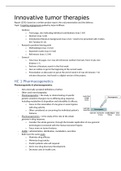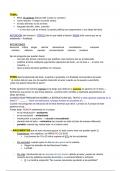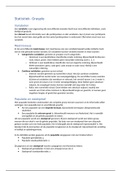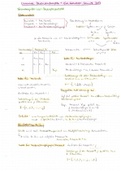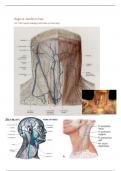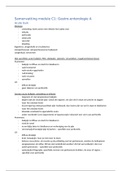Report (25%): based on a written project report, the oral presentation and the defence.
Topic: Targeting angiogenesis guided by Arjan Griffioen.
- Outlines:
o Front page, also indicating individual contributions (max 1 A4)
o Abstract (max ½ A4)
o Introduction/literature background (max 2 A4) > need to be presented with 3 slides
this Tuesday (6-12).
- Research question/missing point
o Methodology (max 1-2 A4)
o Expected results (max 2-3 A4)
o References (max 1-2 A4)
- General
o Total max 10 pages, incl. max 20 references (uniform format), front 11 pts, line
distance 1 ½.
o Perform a literature search in the first week
o Give an outline in ppt at the beginning of the second week.
o Presentation an discussion in ppt at the end of week 3 of max 20 minutes + 10
minutes discussion. And hand in a digital version of the project.
HC 1 Pharmacogenetics
Pharmacogenetics & pharmacogenomics:
- Not universally accepted definitions of either.
- Often used interchangeably.
- Pharmacogenetics = the study or clinical testing of specific
genetic variations that give rise to differing drug response,
including metabolism & disposition and tolerability & efficacy.
o Focus on the association of one gene or several genes
with drug activity.
o Often considered as concerning the individual patient’s
features.
- Pharmacogenomics = is the study of the role of the whole
genome in drug response.
o Consider the whole genome, through the broader application of new genomic
technologies (connected with the Human Genome Project).
o Focus more on tumor features.
- AMDE = administration, distribution, metabolism, excretion.
- Both have the same goals:
o Maximize drug efficacy.
o Minimize drug toxicity.
o Predict patients who will respond.
o Aid in new drug discovery/development.
o Decrease costs in health care.
,Technology & economic revolution:
- The costs per human genome is decreasing, which is a good thing.
- There is a grow in a number of approved medicine with their
associated biomarker.
- With technology we thrive to go for different patient groups
responding to different drugs which can be found out by specific
biomarkers.
- Unfortunately, interindividual differences in drug efficacy may stem
from PK and/or PD and have both genetic and nongenetic causes.
o Causes: genetic variability, inadequate dose, different age
and organ function, interaction with drugs and environment.
o Strategies to improve drug efficacy: drug monitoring,
pharmacovigilance and pharmacogenetic studies.
Polymorphisms:
A polymorphisms is a DNA variation in which a possible sequence is present in at least 1% of people
and includes SNPs and other DNA alterations such as tandem base repeats.
- SNP = single nucleotide polymorphism; a DNA variation in which only one nucleotide differs
between reference and variant.
- More than 99% of human DNA sequences are the same across the population. Of the <1%
differences, over 90% are SNPs, which occur every 300-3000 bases along the 3-billion-base
human genome.
- Resources include:
o NCBI’s sequence database
o The SNP Consortium and HapMap website
o Celera database
o The NCI’s snp500 database
o The Japanese SNPs database
Contribution of genetic polymorphisms to drug metabolism
Phase 1 metabolism consists of reduction, oxidation, or hydrolysis reactions. These reactions serve to
convert lipophilic drugs into more polar molecules by adding or exposing a polar functional group
such as -NH2 or -OH.
Phase 2: attach to the drug to make the compound more polar for elimination out of the body.
Reactions consist of adding hydrophilic groups to the original molecule, a toxic intermediate or a
nontoxic metabolite formed in phase I, that requires further transformation to increase its polarity.
These reactions include conjugation reactions, glucuronidation, acetylation, and sulfation.
Example pharmacogenetic test with irinotecan:
- In the promoter region of the UGT1A1 gene, the presence of 7 TA
repeats is associated with reduced UGT1A1 activity when compared
with promoters that contain 6 TA repeats.
- The reduced expression of UGT1A1 prevents glucuronidation of SN-
38, so SN-38 accumulates and cause toxicity.
- The FDA-approved drug label for irinotecan states that “when
administered as a single-agent, a reduction in the starting dose by at
, least one level of irinotecan hydrochloride injection should be considered for patients known
to be homozygous for the UGT1A1*28 allele.
Example pharmacogenetic test with thiopurines:
- Thiopurines are used as anti-metabolites for the treatment of leukemia because it can lead
to apoptosis and decreased inflammation.
- Catabolized by an enzyme: TPMT.
- About 1/300 persons have a severely deficiency in TPMT, and about 10% of the US
population has a lower level of TPMT. Both groups are at an increased risk for thiopurine
drug toxicity, which can affect the activity of the bone marrow and lead to hematopoietic
toxicity.
- In 2004, the FDA approved a TPMT enzyme diagnostic test and made recommendations
regarding the inclusion if advice about TPMT testing in thiopurine drug packing.
- Several labs are offering different testing for TPMT, evaluating polymorphisms and drug
metabolites.
Example pharmacogenetics of gemcitabine:
- Used as a first line drug in NSCLC and pancreatic patients.
- Prodrug which can be inactivated by CDA.
- Polymorphisms of lysine 27 glutamine (Lys27Gln, resulting from a substitution) in the CDA
gene > different CDA activity and expression.
o Higher activity in heterozygous Lys27gln or homozygous Gln27Gln.
o More than 17 different polymorphisms.
- Polymorphisms has a significant association with the overall survival of the patient.
- When the patients had the heterogenous allele (the polymorphism), there was an increased
CDA activity > lower overall survival.
Validation:
A major drawback has been the lack of a systemic approach to
advancing the use of biomarkers in anticancer drug
development. Hopefully, novel biomarkers will be validated in
prospective studies in the near future.
Suggest that some specific DNA variation can influence a specific
enzyme and thereby also alter drug efficacy in patients.
Expanding “precision oncology” studies to embrace complexity:
- Precision oncology relies in indiscriminate sequencing of
genomes in biopsies that barely represent the heterogenous mix tumor cells.
- So-called ‘driver mutations’ are not actual omnipotent drivers, but represent molecular
lesions that are causatively necessary but not sufficient for pathogenesis.
- Non-genetic heterogeneity is a critical consideration as cells respond to broad,
environmental perturbations and drug treatments by converting to many other cell states,
including stem-like, resistant cell phenotypes.
- New technologies for studying genetic and non-genetic cell population heterogeneity, tumor
cell plasticity, and intercellular communication are warrant.
Take home:
, - Whilst pharmacogenetics in generally referred to study genetic variations leading to varied
responses to pharmaceutical products; pharmacogenomics is a broader application of
genomic technologies for development of new drug and/or further categorization of existing
drugs.
- Pharmacogenetics can help prevent adverse events or improve drug efficacy by enabling
physicians to optimize dosage or to avoid a medication with adverse reactions and to
prescribe an alternative therapy.
- Precision oncology, defined as molecular profiling of tumors to identify targetable
alterations, is rapidly developing and has entered the mainstream of clinical practice.
- Precision does not mean narrow!
- With new technologies for studying genetic and non-genetic cancer cell population
heterogeneity, and tumor cell plasticity, we can achieve a new precision and hopefully guide
better diagnostic/prognostic/predictive and preventive studies.
HC 2 Overview conventional therapies
In general: targeted therapy is a therapy directed against a specific property of a cancer cell and not
in a normal cell.
Types of drugs: chemo-, targeted-, anti-angiogenesis-, hormonal-, immuno-, monoclonal antibody
therapy. Almost always in combination with conventional chemotherapy!
1. Overview therapies – What is chemotherapy?
Classical definition of chemotherapy, it needs to be:
- Non-selective
- All DNA-directed
- Cytotoxic
- All toxics chemical
- Typical one drug for all
Mechanism of actions:
- Antimetabolites affect the DNA synthesis.
- Alkylating agents affect the DNA itself by inducing
double strand breaks > cell will die.
- Intercalating agents intercalate between the two
strands so the DNA can’t be transcribed or
duplicated.
- Spindle poisons affect DNA duplications.
- Targeted drugs like monoclonal antibodies interfere
with the stimulating proteins or tyrosine kinase 1
blockers inhibit the phosphorylation of the tyrosine
kinase receptor in order to affect gene transcription.
1. Overview therapies – Benefit of chemotherapy.
Cure rates mostly indicate combinations of chemo- with radiotherapies or surgery.
- Breast 78-96%


